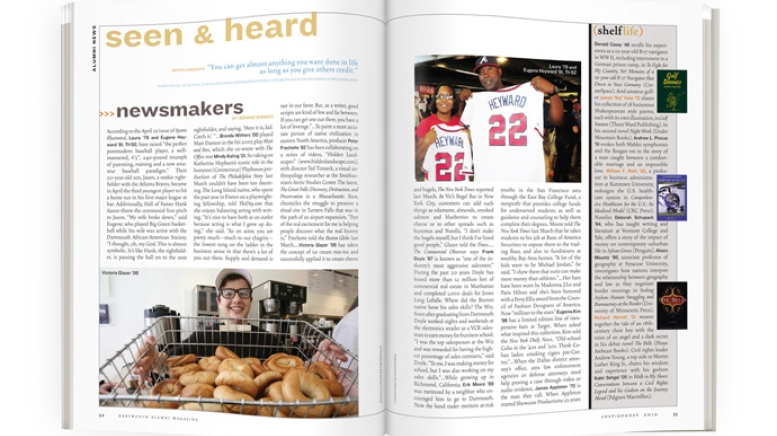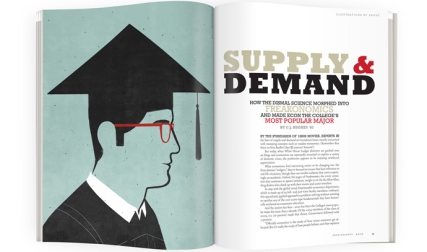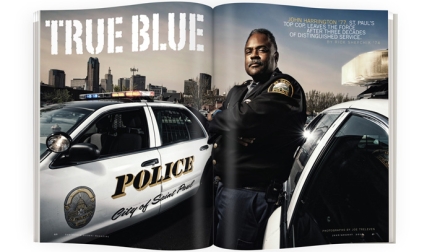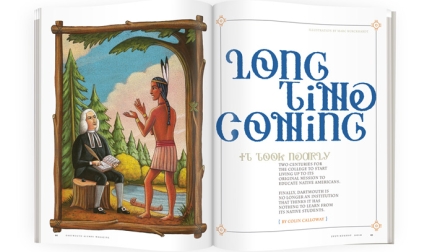According to the April 19 issue of Sports Illustrated, Laura ’79 and Eugene Heyward ’81, Th’82, have raised “the perfect postmodern baseball player, a well-mannered, 6’5”, 240-pound triumph of parenting, training and a new amateur baseball paradigm.” Their 20-year-old son, Jason, a rookie rightfielder with the Atlanta Braves, became in April the third youngest player to hit a home run in his first major league at bat. Additionally, Hall of Famer Hank Aaron threw the ceremonial first pitch to Jason. “My wife broke down,” said Eugene, who played Big Green basketball while his wife was active with the Dartmouth African-American Society. “I thought, oh, my God. This is almost symbolic. It’s like Hank, the rightfielder, is passing the ball on to the next rightfielder, and saying, ‘Here it is, kid. Catch it.’ ”
Brenda Withers ’00 played Matt Damon in the hit 2003 play Matt and Ben, which she co-wrote with The Office star Mindy Kaling ’01. So taking on Katherine Hepburn’s iconic role in the Ivoryton (Connecticut) Playhouse production of The Philadelphia Story last March couldn’t have been too daunting. The Long Island native, who spent the past year in France on a playwrighting fellowship, told TheDay.com that she enjoys balancing acting with writing. “It’s nice to have both as an outlet because acting is what I grew up doing,” she said. “As an actor, you are pretty much—much to our chagrin—the lowest rung on the ladder in the business sense in that there’s a lot of you out there. Supply and demand is not in our favor. But, as a writer, good scripts are kind of few and far between. If you can get one out there, you have a lot of leverage.”
To paint a more accurate picture of native civilization in eastern North America, producer Peter Frechette ’82 has been collaborating on a series of videos, “Hidden Landscapes” (www.hiddenlandscape.com), with director Ted Timreck, a visual anthropology researcher at the Smithsonian’s Arctic Studies Center. The latest, The Great Falls: Discovery, Destruction, and Preservation in a Massachusetts Town, chronicles the struggle to preserve a ritual site in Turners Falls that was in the path of an airport expansion. “Part of the real excitement for me is helping people discover what the real history is,” Frechette told the Boston Globe last March.
Victoria Glazer ’06 has taken the concept of ice cream mix-ins and successfully applied it to cream cheese and bagels, The New York Times reported last March. At Vic’s Bagel Bar in New York City, customers can add such things as edamame, almonds, smoked salmon and blueberries to cream cheese or to other spreads such as hummus and Nutella. “I don’t make the bagels myself, but I think I’ve hired good people,” Glazer told the Times.
The Commercial Observer says Frank Doyle ’87 is known as “one of the industry’s most aggressive salesmen.” During the past 20 years Doyle has leased more than 12 million feet of commercial real estate in Manhattan and completed 1,000 deals for Jones Lang LaSalle. Where did the Boston native hone his sales skills? The Wiz. Soon after graduating from Dartmouth Doyle worked nights and weekends at the electronics retailer as a VCR salesman to earn money for business school. “I was the top salesperson at the Wiz and was rewarded for having the highest percentage of sales contracts,” said Doyle. “To me, I was making money for school, but I was also working on my sales skills.”
While growing up in Richmond, California, Erik Moore ’89 was mentored by a neighbor who encouraged him to go to Dartmouth. Now the bond trader mentors at-risk youths in the San Francisco area through the East Bay College Fund, a nonprofit that provides college funds for underserved students as well as guidance and counseling to help them complete their degrees. Moore told The New York Times last March that he takes students to his job at Banc of America Securities to expose them to the trading floor, and also to fundraisers at wealthy Bay Area homes. “A lot of the kids want to be Michael Jordan,” he said. “I show them that suits can make more money than athletes.”
Her hats have been worn by Madonna, J.Lo and Paris Hilton and she’s been honored with a Perry Ellis award from the Council of Fashion Designers of America. Now “milliner to the stars” Eugenia Kim ’96 has a limited edition line of inexpensive hats at Target. When asked what inspired this collection, Kim told the New York Daily News, “Old-school Cuba in the ’40s and ’50s. Think Cuban ladies smoking cigars pre-Castro.”
When the Dallas district attorney’s office, area law enforcement agencies or defense attorneys need help proving a case through video or audio evidence, James Appleton ’70 is the man they call. When Appleton started Showcase Productions 23 years ago, he worked mainly with corporate clients producing commercials. But after helping a police officer friend with a case, he branched out into crime-fighting work. Since then he has used video enhancement to prove a customer pretended to slip after throwing guacamole on the floor of a Wendy’s, and he helped demonstrate that Stacey Brown, a man who looked remarkably like his accomplice, was the one who shot a convenience store owner. “Jim was able to take out all the fuzz and focus in on Brown’s features,” prosecutor Brandon McCarthy told the Dallas Morning News last December. “He was able to zoom in on a very distinctive tattoo on his right arm, as well as the shape of his ear and an earring in the left one.” Overwhelmed by Appleton’s evidence, the defendant ultimately confessed his guilt during cross-examination.
Dr. Flagg Miller ’91 is working on a book about Osama Bin Laden that focuses on the content of audiotape recordings acquired by CNN in 2001 from Bin Laden’s former neighbors in Qandahar. Miller, an associate professor of religious studies at the University of California at Davis, has been annotating the 1,500 recordings from digital copies (the originals are housed at Yale). The majority of recordings feature speeches by more than 200 Islamist preachers, as well as everyday conversations between jihadis about such mundane things as cooking eggs. Twenty-three recordings feature Bin Laden, who can be heard speaking at a wedding and reading his original poetry. Miller told The Chronicle of Higher Education that one cassette, titled Listen, Plan and Carry Out Al Qaeda, reveals that, “They see it as an ethical calling. That may be difficult to swallow, but it’s important to deal with.”
Two years ago, when demand began to dwindle for traditional interior design services, Betsy Burnham ’84 created Instant/Space, a customized room design plan. Burnham and her assistants work with clients online and over the phone for a flat fee per room and then mail a detailed design plan that the customer then executes. “We try to make the implementation of the plan as simple as possible by selecting specific pieces and showing exactly where they’ll lay them out in the room,” Burnham told Lonny Magazine in February.
Zack Berke ’02 is technology director of a San Francisco-based nonprofit, Eureka Fund, which launched online in December and enables the general public to donate money for scientific research. Donations will help fund two Stanford researchers who are studying how car batteries are used to supply electricity to residents in Third World countries. This is currently Eureka Fund’s sole project, as Berke and founder Jason Blue-Smith measure the effectiveness of applying crowd-financing to funding scientific research. As of mid-May the fund had raised $2,300 toward its $23,000 goal, and future projects are already on deck for wind, transportation, and energy storage research. As Blue-Smith told The New York Times in April, this crowd-sourced funding is crucial, especially for early-stage scientific ideas. Even when “the scientists have a relationship with an angel investor for a for-profit,” he said, “they still can’t get money to fund the really interesting, high-quality academic research that they believe in passionately.”
A Boston Globe reporter and videographer accompanied Stormy Mayo ’65 on a research outing off the coast of Cape Cod, Massachusetts, last April. Mayo, one of the founders of the Provincetown Center for Coastal Studies, and his colleagues were studying a group of endangered North Atlantic right whales that were feeding on zooplankton. The whales now number fewer than 450 and, as Mayo pointed out, it is often while feeding that they get entangled in fishing gear or sustain injuries from colliding with boats. “When they are feeding, they seem to be oblivious,” said Mayo.




